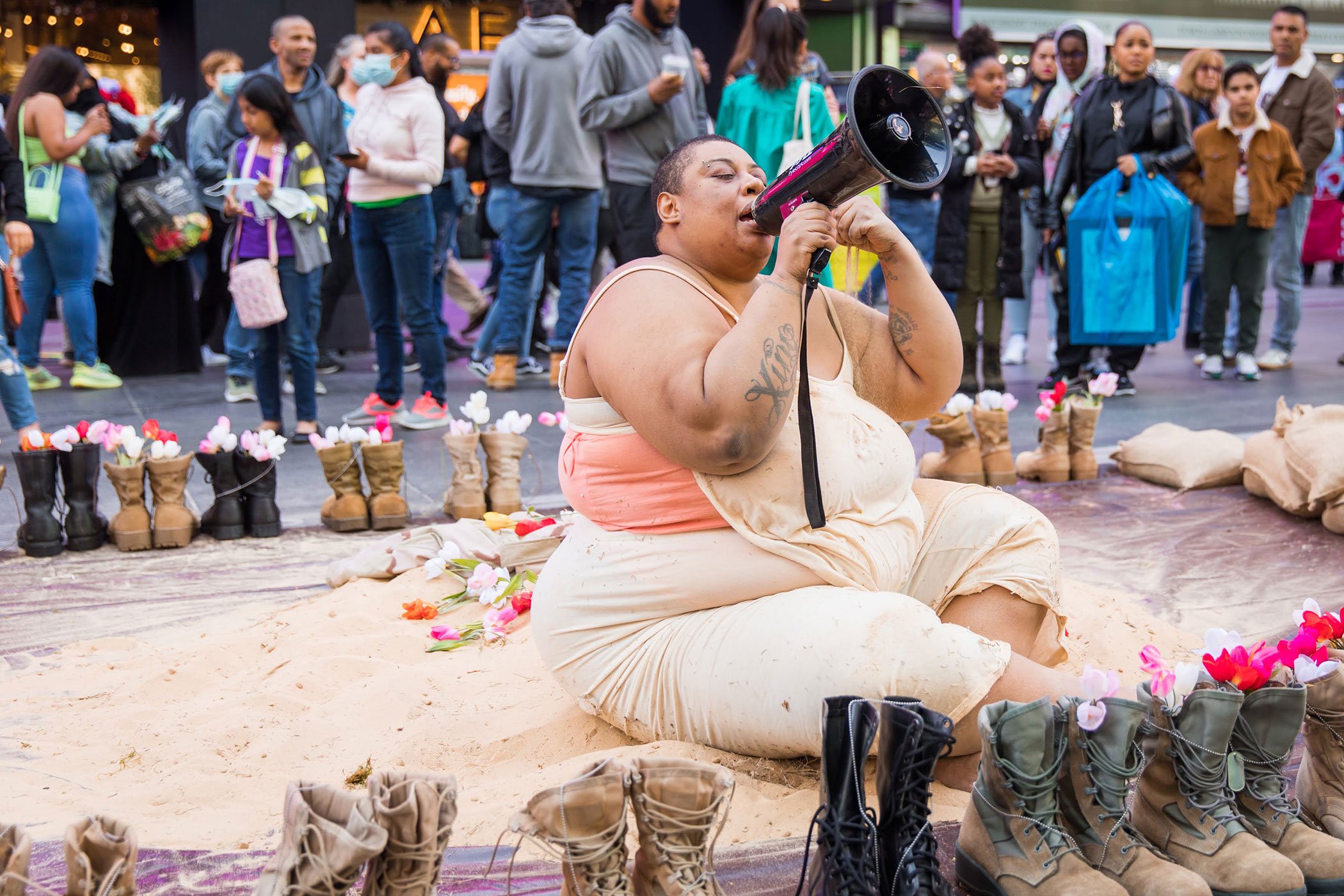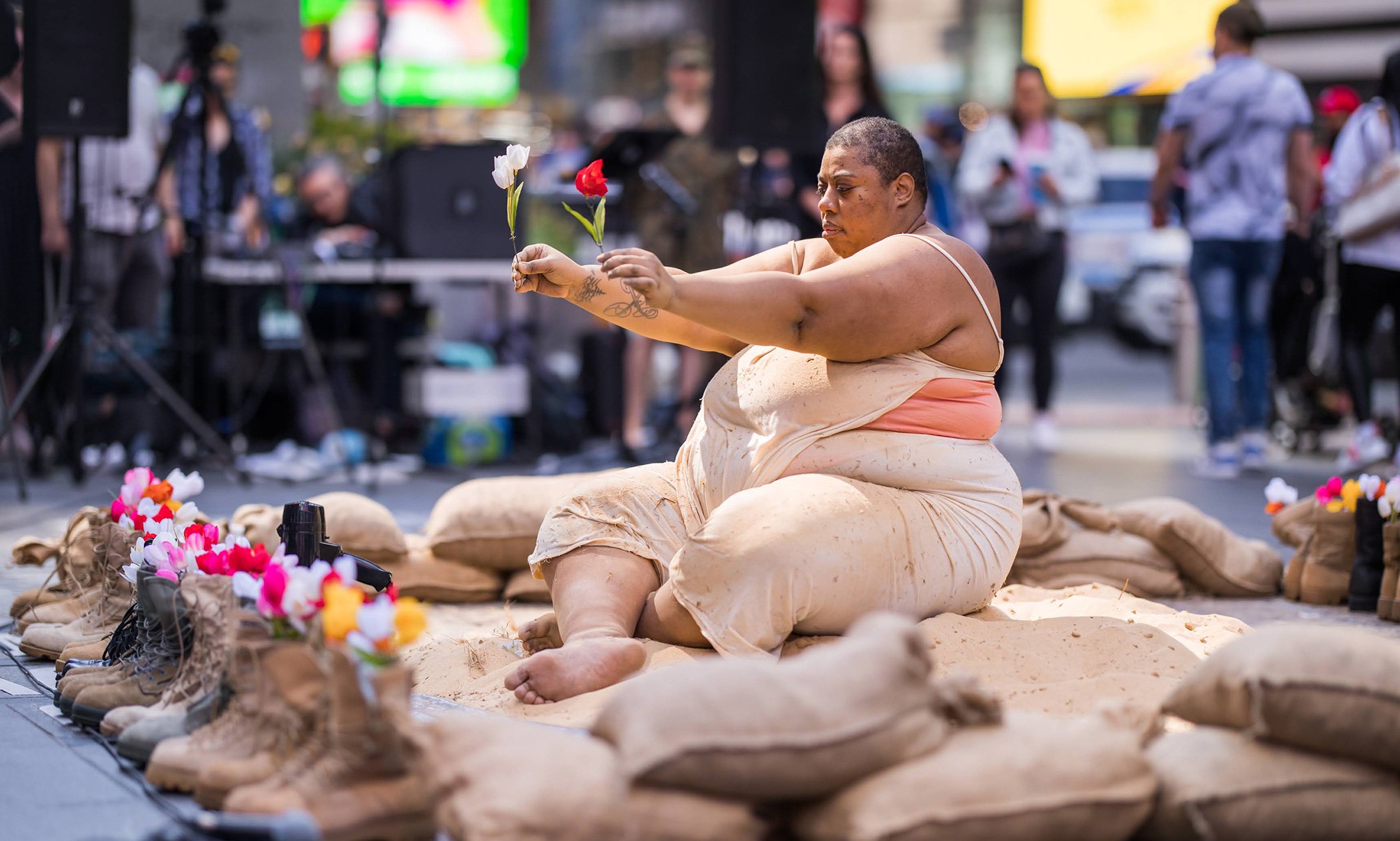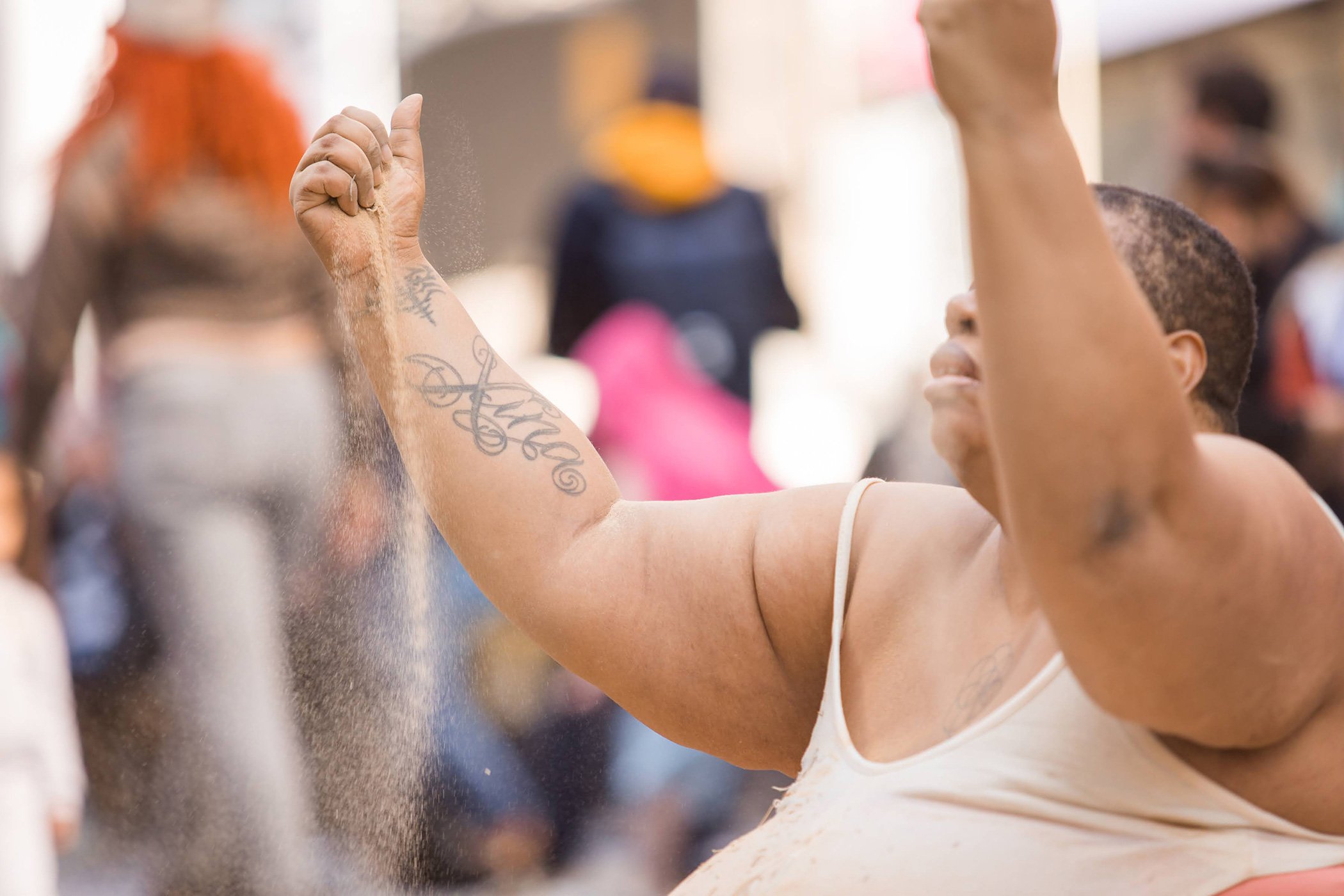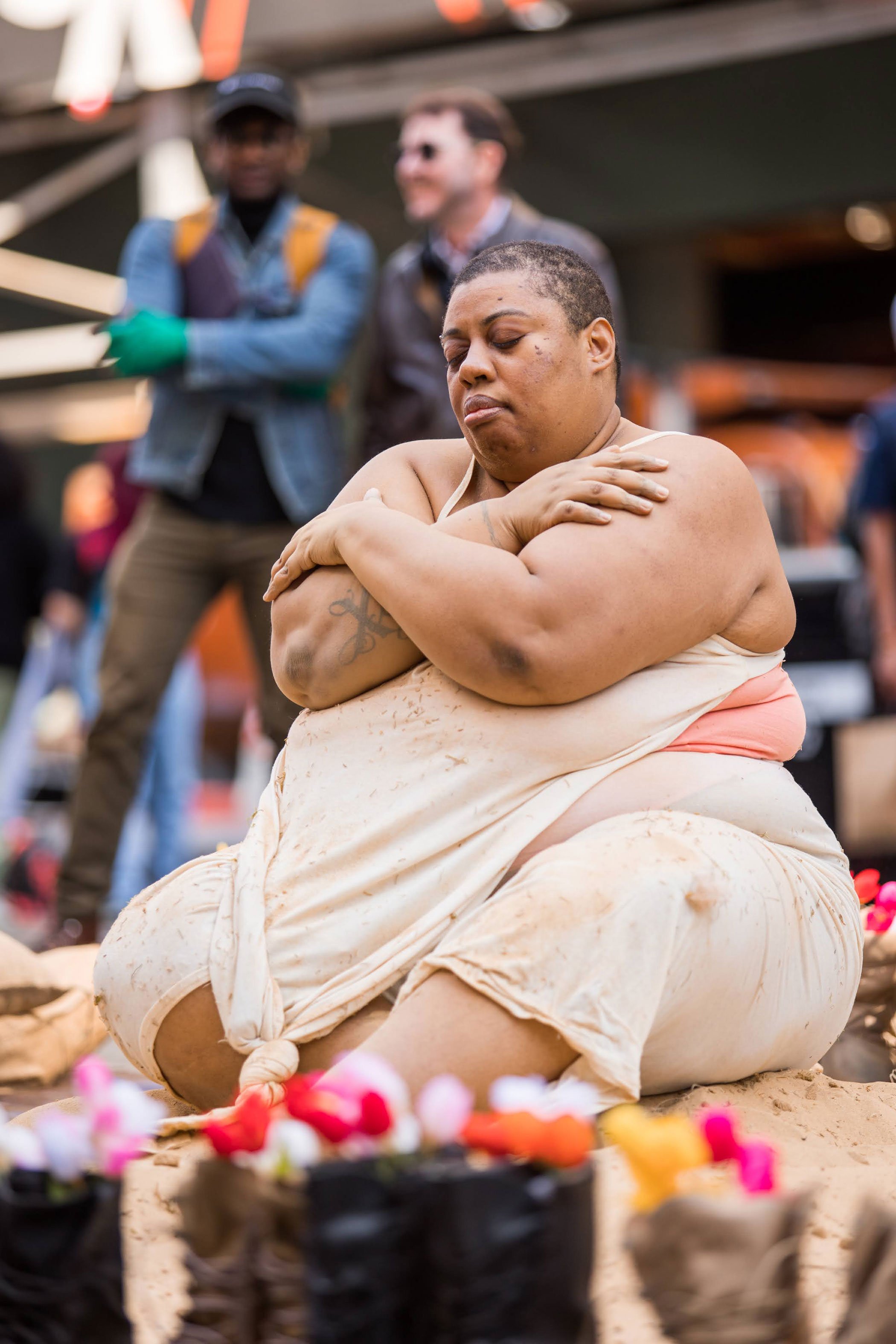When I first met Nicole Goodwin – who now goes just by GOODW.Y.N. – we were both undergrads at City College, where she studied creative writing. One day, Nicole strolled into the dean’s office, where I worked as a college assistant registering students for classes. Her warmth, humility and infectious laughter instantly put me at ease. I learned from her repeat visits that Nicole was a doting mother, an Iraq war veteran, and a gifted spoken word artist.
The first time I heard Nicole spit was at Spoke ‘N’ Heard, our school’s slam poetry club. I was stunned the first time I witnessed her bring the house down with her raw and resonant poems. She wrote often of her “people-parts” — the things that bring her all manner of attention in our society. Her Blackness. Her womanhood. Her queerness. Her size.
It was around graduation time that Nicole debuted her “Ain’t I a Woman (?/!)” performance series, in which she combined the rawness of her spoken word poetry with symbolic props and a mix of choreographed and unchoreographed movement. She would regularly disrobe during these performances, tenderly exposing a naked body our society normally expects us to shun. Similar to the homeless individual begging on the streets and subway cars of New York, Nicole’s fat, Black, feminine, mentally ill body has a tendency to be treated as abject by the average viewer, who might not immediately recognize her performance art as a form of creative expression. Regardless of its reception, Nicole’s art is an attempt to put her suffering body on display, bringing into sharp focus the mental and physical scars incurred throughout her life. As a firsthand witness to the appalling treatment of Iraqi civilians and prisoners by her American comrades, Nicole counts her military involvement among those scars.
Since debuting “Ain’t I a Woman (?/!),” Nicole has steadily deepened her performance practice, participating in mentorships, exhibitions, and public art festivals that have served to heighten the impact of her daring oeuvre. Last summer I had the pleasure of interviewing Nicole – GOODW.Y.N. – at her home in East Harlem. Despite following her artistic growth for many years, interviewing her that day in her element offered me even more insight into her ever-evolving practice. We discussed “Ghost of Myself and You: Mothers of the Disappeared,” a public performance piece she debuted last month in New York City in collaboration with DEMIL Art Fund and Poetic Theater Productions that addresses the emotional devastation wrought by the Iraq and Afghanistan Wars. GOODW.Y.N, herself, served in Iraq in 2003 with the Army. We also talked about surviving the military, interrupting ourselves to swap stories about angry passersby during her performances.
Ghost of Myself and You: Mothers of the Disappeared, performed at Times Square New York, 2022. Photos by Bjorn Bolinder.
Zachary Frater (ZF): I was hoping you could talk about your name change. Because I know you as Nicole, and I feel like I’m being introduced to you in a new way now with a new name. You’re doing different kinds of work that I haven’t seen before. I thought it would be interesting if you wanted to [tell us about] the history of “GOODW.Y.N.”
GOODW.Y.N.(G): The new-new! I think I owe a lot of it – and blame a lot of it – on “Ain’t I a Woman (?/!),” because the ability to bare skin and breast and bone in public gives you a laissez-faire attitude. You just stop giving a shit. With the name change, it was more of an identity change. I didn't feel like Nicole Goodwin covered where I was going and who I was. I feel like GOODW.Y.N. can time travel. There’s a piracy to that. I met other people who are pirates, and what I mean by pirates is that they know how to harness time and space and [the] afrofuturism that they embody. I’ve met other people who do that and I've studied their ways.
ZF: Who do you consider to be a pirate?
G: Oh man – Ebony Noelle Golden. She’s amazing! With her direction and her body movement and dance. She very much is a pirate. She has a tendency to warp emotion and to conjure up this space for all with her work. I admire her a lot.
ZF: Would you like to explain the project “Ghost of Myself and You”?
G: First of all, the installation portion of the sandbox is a repurposing of the spirits. So it’s taking the spirits of the [US] soldiers and using them to protect the civilians that are living or dead that need that protection. It’s a recasting of their presence and their power. I’m using these images: the sandpits, the flowers, the dogtags, not just to repurpose, but to conjure up time and space. To say, “Hey, this is Iraq. This is Afghanistan.” Even though we’re divided by an ocean, there really isn't a divide because people are displaced there. So I’m bringing this mourning and this celebration and all these contradictions to life in one space. And I’m doing it at Times Square because there’s a recruitment station that’s down the block and I wanted to get these two physical spaces as close to each other [as] possible, and to show the consequences of war, which is death! And the necessity to mourn. We haven’t been given any opportunity to mourn these wars. And then we wonder why our children are running around with anxiety. We’ve been carrying this weight for about 20 years! So it’s conjuring up the ghosts and saying, “You are present. You are here. You are a part of us.” And showing that compassion and love. That’s what it’s about.
Ghost of Myself and You: Mothers of the Disappeared, performed at Times Square New York, 2022. Photos by Bjorn Bolinder.
ZF: What else do you want people to know about the project?
G: How being separated from [my daughter] for nine months [during my Iraq deployment] plays into “Mothers of the Disappeared.” It’s hard to talk about because I’ll never get those nine months back. She was a month and three weeks and I came back and she was 10 months old. And it was hard because at the bottom of it all, I left out of spite. I really wanted to prove to my unit that I was of value. I saw so many kids in Iraq without parents – just orphans. Their parents had been killed or maybe they abandoned them – we didn’t know their stories. And it was hard to see the boys because the boys were out on the streets. I remember distinctly, there was a mentally challenged boy who slept in a trash bin, and I heard about him over the radio – the comms communication – and he had nowhere else to go. And I think of these children a lot. I think of my daughter, how she plays into it and how her depression and her PTSD and her anxiety stems from the things that happened to me. And I often question, “Did I do the right thing?” A lot of good has come out of my service for me personally, being honorably discharged, but a lot of problems and challenges have come out of it as well. I think “Mothers of the Disappeared” is like a tribute to those children as well as a testament to family and the endurance of love.
ZF: You said you’ve been trying to tell this story…
G: I’ve been trying to tell this story about Iraq and Afghanistan for five years. Afghanistan was just this missing, disappeared link. Not only in my life, but in the lives of civilians. It just was going on and on and on. Iraq was more like an open-and-shut case, but for me, [Afghanistan] was this huge mystery, because we just stopped talking about it. It went from we talked about it all the time to [claps] this silence. I don’t know what to claim Iraq as. For me, it’s a big void. It’s like a check that doesn’t cash. I’m trying to give it meaning and give it purpose, but the only way to do that is to speak its name. To say things like: “Iraq is a place. Iraqis are people. Afghanistan is a place. Afghans are people.” You have to give it merit.
Ghost of Myself and You: Mothers of the Disappeared, performed at Times Square New York, 2022. Photos by Bjorn Bolinder.
ZF: Could you tell me how your experience in the military made you more aware of your otherness, or the ways that your experience was “other” compared to the main narrative?
G: Well, first of all, when you realize you’re queer in a space that is hyper-homophobic, you realize your otherness. You gotta keep people on their toes. I think that was the privilege of my [bi]sexuality for me: this learned ability to keep people guessing. It made me more aware of my Blackness, my womanhood – the people-parts of me that were crying out.
ZF: Did you feel more aware of those facets of yourself after the military than before?
G: Yeah. I was oblivious, because I had art, and I just saw myself as a person and everybody was a person and I’m putting flowers in fucking rifle holes.
ZF: Got it, yeah. [Laughs] I know what you mean.
G: Very peaceful. And now I am not a pacifist. And it’s like, what does it mean to be a warrior and a woman? What does that mean? It means sometimes you’re shadowboxing. You’re fighting people that love you. You’re pulling away anchors [from] people that are like, “I just want to nurse you. I just want to heal you.” So angry. So angry. I was so angry for years. The resentment of survival. And no one says that. It’s easy to be a hero when you’re dead, or when you’re so infirm that you can barely move. People can project these concepts on you and that’s what I’ve always been afraid of. That’s what I’ve always been afraid of: this vicariousness, these concepts, these myths and fables. These narratives that are saturated with saccharine. All sugar.
ZF: Do you see parallels between being a soldier and being an artist, specifically in terms of heroism?
G: Not necessarily in terms of heroism. Because when I was a soldier I was pretty much a coward. I ran from the danger as far as I could. As an artist I run to the danger as fast as I can. I don’t know why. I think because I'm in my element. When you're in your element, things like courage and bravery come naturally because it’s not a facade. You’re not trying to hold up an image that’s not your face. You’re a fish in the ocean, or a whale – you know what I mean? You’re in your nature. So these things – these attributes of bravery and courageousness and heroism – they come out easily. Whether they exist or not is not even a question. Everybody has their moment of clarity and bravery and cowardice. One cannot exist without the other. You gotta have a moment of cowardice in order to have a moment of bravery.
ZF: I agree.
G: When you make the art that I make, there’s no moment to label shit. You just do it because you have something to say. Everything that I’ve done within the last five to ten years is me having something to say. Even the name change is something that has meaning, something coming out of this body to say. The one thing it can’t be is art for art’s sake. It can’t be that. I think a lot of that is because I'm a Black, queer woman. The message has to be potent and present because of the fact that so many of us don’t get that notoriety.
ZF: Do you ever find your position challenged?
G: All the time. By people that look like me, and that’s what hurts the most. It hurts! I was attacked when I did Art in Odd Places. This Black woman poured chunky cold soup on me and said, “A bird shit on you.” Not only did I feel violated, I felt betrayed. And I couldn't express that to the [festival staff] around me. They created a barricade around me, but they also blocked themselves off from hearing me. I was just “the artist.” I wasn't a person. But, I am often challenged and then say, “All right!” [claps] I’mma get up and do it the next day because I said I was going to do it. Despite my daughter’s tears, despite [my roommate’s] anger -- because he saw it as martyrdom.
ZF: Right, right.
G: Some people have been adversarial and downright angry over the years. Especially women. “Why do you feel the need? [What is] the purpose? What is this for?” Dot-dot-dot-dot.
ZF: I witnessed some of the anger that you talk about. When you did Art in Odd Places, besides the soup lady there was this other guy -- I was trying to film people’s reactions, but one person saw me filming him and he got upset. But I filmed him because he was having a strong reaction. He saw you with the flag and —
G: Bloody flag.
ZF: I assume [that] is what caused the reaction. He was on the phone talking about it and he was like, “You can’t believe what I just saw, this is ridiculous! I can’t believe this is happening!” Almost like he was affronted. And I’m just like, “It’s not happening to you. It’s not about you. But if you’re offended, maybe it is.” [Laughs]
G: How do you fit in?
ZF: Because [the piece] is about America. That’s why I was just like, “Oh, maybe he’s ex-military. Maybe he’s current military.” I don’t know. People have really strong reactions sometimes.
G: I’ll never forget, there was this little saying that they made us say while we were training: “What makes the green grass grow?” And we would say, “Blood! Blood. Blood makes the green grass grow.” And when you sit there and you show people that, all of a sudden they’re angry. No. This is the cost of our prosperity. Is it worth it? Blood everywhere.
Ghost of Myself and You: Mothers of the Disappeared, performed at Times Square New York, 2022. Photos by Bjorn Bolinder.
Zachary Frater is a New York City-bred freelance writer & curator with over 10 years of experience using the written word and cultural programming to center the lives of queer and trans creatives of color. He has produced a diverse array of art exhibitions, artist talks, panel discussions and other live events in collaboration with NYC artists, venues, and community organizations. In 2016, his live talk show Legends, Statements & Stars! featuring local LGBTQ artists of color was showcased at JACK, Dixon Place, Poetry Project and La MaMa. Zachary’s interviews and cultural criticism have been published by the Helix Critical Project, BX200 and Visual AIDS.
Nicole Goodwin aka GOODW.Y.N. is the author of Warcries, and the poetic sequel Warcrimes as well as the photographic essay book Ain't I a Woman (?/!): I Give of Myself based on the five year iterations of Ain't I a Woman (?/!). They are a finalist for the CUE Foundation’s 2022 Public Programs Fellowship, as well as the 2020 Pushcart Nominee, 2018-2019 Franklin Furnace Fund Recipient, the 2018 Ragdale Alice Judson Hayes Fellowship Recipient, 2017 EMERGENYC Hemispheric Institute Fellow and the 2013- 2014 Queer Art Mentorship Queer Art Literary Fellow. They published the articles ``Talking with My Daughter…” and “Why is this Happening in Your Life…” in the New York Times’ parent blog Motherlode. Additionally, their work “Ain’t I a Woman (?/!): Poems,” was longlisted for The Black Spring Press Group’s The Christopher Smart-Joan Alice Prize for 2020, and their work "Desert Flowers'' was shortlisted and selected for performance by the Women's Playwriting International Conference in Cape Town, South Africa in 2015.




